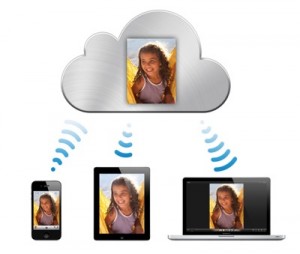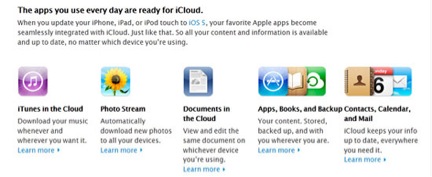♬ Blue skies
Smiling at me
Nothing but blue skies
Do I see…♬
Lyrics and Music by Irving Berlin.
This is a great guest post by Gerry Purdy PHD, the Principal Analyst, Mobile & Wireless services for MobileTrax LLC. I have been reading Gerry’s “Inside Mobile” newsletters for some time now, but this latest one on Apple’s iCloud was a really good analysis of what Apple aims to do with the cloud and – in consequence – how this changes the way we all look at the cloud . So with Gerry’s permission secured, here is his post entitled: Blue Skies Ahead for Apple’s iCloud:
“MobileMe wasn’t our finest hour … we have completely rewritten and integrated it into iCloud.” – Steve Jobs
I had one of those ah ha moments as I watched the replay of Steve Jobs delivering part of the keynote address at last week’s Apple WWDC (World Wide Developer’s Conference) at which he announced that they are opening iCloud to developers by providing a family of application programming interfaces (APIs) that will help developers build cloud-based services. This is basically the same thing that Apple did when it announced the App Store and provided developers with a host of APIs that enabled them to build apps, which have grown to over 425,000.
Did Apple need to also announce an iCloud Store? Not really, because the store front is already there. Developers can now build apps for iOS that reside in the cloud and connect to them via the Internet, typically, over a wireless link such as Wi-Fi or 3G/4G. Watch for an entirely new kind of cloud-based service environment that works in concert with local iOS apps that enable a hybrid between local apps and cloud apps.
These are not just a web browser front end to remote apps (like browsers work today) but, rather, iOS local apps delivered through the App Store that take advantage of working with iCloud apps, giving users a great local experience while doing a lot of the heavy lifting in the cloud.
Figure 1. Nine Core Apps in iCloud
I was also particularly impressed with Apple when Jobs admitted that MobileMe just didn’t work and, as a result, was being completely rewritten.
There are nine basic cloud apps that Apple built and form the foundation for iCloud:
1. Contacts, 2. Calendar and 3. Mail: Calendar, Contacts and Mail sync are the three most basic sync services provided in iCloud. If Apple gets this right, then they will offer a lot of benefit for many PC, Mac and iOS users. This enables you to see updates almost instantaneously on any of your devices (other than competitive smartphones and tablets). iCloud includes guest access via a browser, which is important when you want to have a family member, friend or business associate get access to your information.
4. App Store: With iCloud, Apple makes it easy to automatically install each of your iOS applications across your different devices. While this sounds really cool, it’s not very practical. Most of your iPhone apps are relevant for your iPhone and not for your Mac, PC or iPad. But, it does bring into one place all of your apps that makes it almost trivial to migrate (upgrade) to a new device.
5. iBook Store: iCloud enables you to view any book that you order on any of the allowable iCloud devices, Macs, PCs and all iOS. You can purchase a book on your iPad and read part of it on your iPhone or Mac.
6. Backup: One important by product of syncing information to the cloud is that you get a backup of your data that resides completely outside of your home or office. In case of a migration to a new iOS device, you just log on to your Apple account, and all of the information stored in your account is synchronized to the new device.
7. Documents: One of the annoying problems with both Android and iOS is that they do not have a common file structure that is available to users. Thus, you cannot simply open and view your files and folders via the OS. Rather, its file management is left to the individual apps. Systems such as DropBox are becoming very popular on iOS and Android because they enable one central place in which you can store, review and access all your documents on any mobile device. iCloud supports the backing up of your documents in iCloud and then getting access to them in any Mac, PC or other iOS device. It doesn’t replace DropBox, but it offers many of the same services and makes it automatic for most iOS applications. iCloud includes 5GB of free cloud storage for mail, document storage and backup (not including music and photos). Users can purchase additional storage, which is not yet priced. Purchased music, apps, books and Photo Stream do not count against the storage limit. iTunes Match will be available for $24.99 per year.
8. Photos: iCloud will automatically upload the most recent 1,000 photos and share them on your iOS, Mac and PC. If you want to keep them on the other devices, you just move them to a photo folder. This restriction of 1,000 photos is because storage is so much larger on a typical notebook (750GB) than on mobile devices (up to 64GB). Although Apple didn’t specifically include videos, we presume the policy will be similar once the service goes live this fall.
9. Music: First, iCloud will automatically sync all of your iTunes Store music purchases to all of your devices. Apple incorporates a very clever service called Music Match that scans your iTunes music library and then looks up those songs on the iCloud music library (via licenses from the music labels) and creates a cloud-based library of your songs without having to upload them from your iTunes library. And, Music Match gives the user an option to upgrade the quality of songs on their own library and access to those songs on any of your devices.
Figure 2. New Features in iOS 5.
As part of the iCloud address, Apple also announced iOS 5, which provides 250+ enhancements to iOS:
Notifications: They no longer pop up in the middle of the display as they do now. Rather, notifications are all managed in one area that the user can see by swiping down from the top of the iOS display. From there you can select and manage your notifications.
Newstand: Apple wanted to create an easy way for people to subscribe to magazines, newspapers and periodicals such as Time or Newsweek. They have set up the same user interface as the one used in the iBook Store but have populated the online library with subscription-based periodicals. For each subscription, Newstand will automatically download the next issue without the user having to do anything. This should help migrate more people from physical printed magazines and newspapers to tablets.
Twitter Integration: iOS 5 integrates Twitter into the messaging service so that you can tweet within the messaging app itself. For example, with iOS 5, you’ll be able to tweet directly from all your Twitter-enabled apps, including sending photos, camera, Safari, YouTube and maps with a single tap. This will increase the use of Twitter. You can already easily do a post to Facebook.
Safari Reader: One of the problems with reviewing web pages on a tablet is that there is a lot of clutter around the page itself. Apple has incorporated a Reader to Safari that makes reading web-based articles more like reading a full-page document by changing the fonts. They also added a reading list on the left so you can quickly jump to and read prior pages.
Reminders: I had always wished that someone would create a simply hierarchical ToDo list. With Reminders, you can create a category name, for example, groceries, and then populate it with things to remember in that list that can easily be deleted when completed. This could be one of those small things that becomes used by tens of millions of people and might, therefore, be one of the most important new features in iOS5.
Camera Enhancements: Apple has incorporated better image editing features in iOS 5, eliminating the need to own a separate digital camera. And, they make the camera available on the lock screen and let you use the volume up button to take a photo in landscape mode.
Mail Enhancements: Apple has made message viewing and management much easier, for example, composing messages by dragging addresses, and mail now includes a new formatting bar with bold, italics, underline and indention controls. It brings e-mail up to par with what’s available on other mobile operating systems.
PC Free: When you currently turn on an iPad for the first time, it shows a diagram to plug your iPad into your PC r Mac. Now, in iOS 5, that will no longer be necessary. It will simply allow you to register the iPad using a wireless connection. With iCloud, all of your synced information will then show up on that device without having to ever plug it in to a PC or Mac.
iMessage: This service will sync all your messages to all your devices. This allows you, for example, to send a text from your iPhone and then view and add to the message flow from your iPad.
Like iCloud, iOS 5 will be released in the fall with developer support available now. With iCloud and continued enhancements for iOS, there are blue skies ahead for Apple.
J. Gerry Purdy, Ph.D., Principal Analyst, Mobile & Wireless, MobileTrax LLC,
gerry.purdy@mobiletrax.com, 404-406-5309
Thanks Gerry for letting us see nothing but blue skies ahead!






















